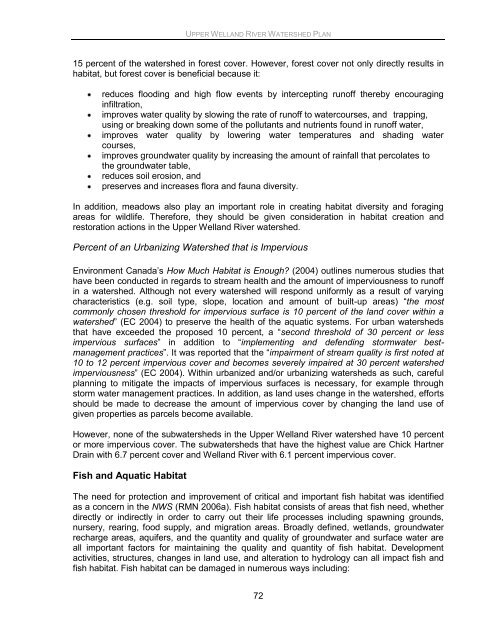Upper Welland River Watershed Plan - Niagara Peninsula ...
Upper Welland River Watershed Plan - Niagara Peninsula ...
Upper Welland River Watershed Plan - Niagara Peninsula ...
Create successful ePaper yourself
Turn your PDF publications into a flip-book with our unique Google optimized e-Paper software.
UPPER WELLAND RIVER WATERSHED PLAN15 percent of the watershed in forest cover. However, forest cover not only directly results inhabitat, but forest cover is beneficial because it:reduces flooding and high flow events by intercepting runoff thereby encouraginginfiltration,improves water quality by slowing the rate of runoff to watercourses, and trapping,using or breaking down some of the pollutants and nutrients found in runoff water,improves water quality by lowering water temperatures and shading watercourses,improves groundwater quality by increasing the amount of rainfall that percolates tothe groundwater table,reduces soil erosion, andpreserves and increases flora and fauna diversity.In addition, meadows also play an important role in creating habitat diversity and foragingareas for wildlife. Therefore, they should be given consideration in habitat creation andrestoration actions in the <strong>Upper</strong> <strong>Welland</strong> <strong>River</strong> watershed.Percent of an Urbanizing <strong>Watershed</strong> that is ImperviousEnvironment Canada‟s How Much Habitat is Enough? (2004) outlines numerous studies thathave been conducted in regards to stream health and the amount of imperviousness to runoffin a watershed. Although not every watershed will respond uniformly as a result of varyingcharacteristics (e.g. soil type, slope, location and amount of built-up areas) “the mostcommonly chosen threshold for impervious surface is 10 percent of the land cover within awatershed” (EC 2004) to preserve the health of the aquatic systems. For urban watershedsthat have exceeded the proposed 10 percent, a “second threshold of 30 percent or lessimpervious surfaces” in addition to “implementing and defending stormwater bestmanagementpractices”. It was reported that the “impairment of stream quality is first noted at10 to 12 percent impervious cover and becomes severely impaired at 30 percent watershedimperviousness” (EC 2004). Within urbanized and/or urbanizing watersheds as such, carefulplanning to mitigate the impacts of impervious surfaces is necessary, for example throughstorm water management practices. In addition, as land uses change in the watershed, effortsshould be made to decrease the amount of impervious cover by changing the land use ofgiven properties as parcels become available.However, none of the subwatersheds in the <strong>Upper</strong> <strong>Welland</strong> <strong>River</strong> watershed have 10 percentor more impervious cover. The subwatersheds that have the highest value are Chick HartnerDrain with 6.7 percent cover and <strong>Welland</strong> <strong>River</strong> with 6.1 percent impervious cover.Fish and Aquatic HabitatThe need for protection and improvement of critical and important fish habitat was identifiedas a concern in the NWS (RMN 2006a). Fish habitat consists of areas that fish need, whetherdirectly or indirectly in order to carry out their life processes including spawning grounds,nursery, rearing, food supply, and migration areas. Broadly defined, wetlands, groundwaterrecharge areas, aquifers, and the quantity and quality of groundwater and surface water areall important factors for maintaining the quality and quantity of fish habitat. Developmentactivities, structures, changes in land use, and alteration to hydrology can all impact fish andfish habitat. Fish habitat can be damaged in numerous ways including:72
















